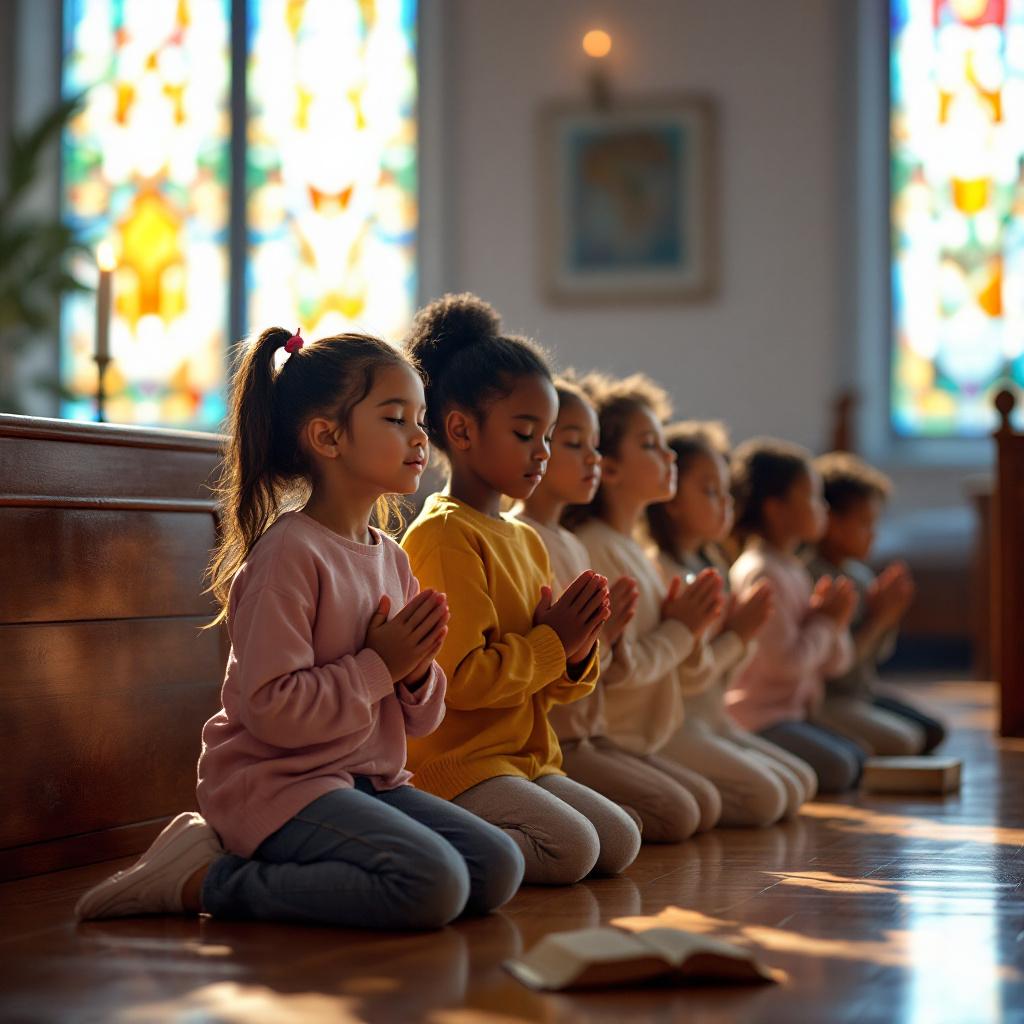School days feel packed from the ringing of the first bell to the final scramble for backpacks. In the rush between classes, projects, and friendships, it's easy to forget the bigger lessons shaping who we become. Bible stories, often told at home or in church, hold steady truths that can guide our choices, encourage kindness, and inspire courage—even in the middle of a crowded hallway.
When we connect ancient stories to our daily routines, we don't just memorize names and places, we bring faith to life right where we need it most. This guide shows students and teachers simple ways to let timeless wisdom shape hallway friendships, tough decisions, and even homework. Let’s see how faith woven into the school day can help us grow, stick together, and make every moment matter.
Why Bible Stories Matter for Students
Bible stories aren’t just words from long ago—they echo through the classroom, over lunch tables, and during bus rides home. These stories teach lessons about kindness, courage, forgiveness, and teamwork in a way that’s easy to remember when life at school gets messy. When students hear about someone like Joseph forgiving his brothers, or Esther standing up for others, they find new confidence to make tough choices and support their friends.

Photo by RDNE Stock project
Shaping Character in School Halls
Every day at school is filled with moments that test patience, honesty, and kindness. Bible stories give students real-life examples of character in action, helping them decide quickly how to treat others and handle hard situations.
- Learning from Others: Stories like Daniel's courage in the lions’ den or the Good Samaritan’s kindness aren't just tales—they’re roadmaps for how to act, speak, and treat people at school.
- Role Models: These stories highlight characters who mess up, learn from mistakes, and try again—just like real students.
- Consistent Values: Hearing about these heroes helps kids strengthen traits like honesty, patience, and empathy, making them easier to show in class and on the playground.
Students often find inspiration from character transformation stories from the Bible, which teach that growth is about progress, not perfection.
Guiding Decisions in Tough Moments
No one likes tough choices, but they’re part of growing up. Whether it’s standing up for someone being teased or choosing to do the right thing when no one’s looking, Bible stories can serve as a gentle nudge in the right direction.
- Practical Wisdom: Stories like Solomon’s wise judgment or Joseph forgiving his brothers show how to weigh options fairly and with compassion.
- Making It Personal: Thinking about how someone from the Bible handled a similar problem can make it easier to see the bigger picture during school drama.
- Pausing Before Acting: Many Bible examples encourage students to slow down, listen, and think before making choices.
For more, check out Bible stories that give a perspective on making tough school decisions.
Creating a Sense of Belonging
School can feel lonely, especially when friendships shift or students feel left out. Bible stories remind students they’re not alone, and that everyone’s welcome around the table.
- Belonging Through Shared Stories: Knowing that heroes like David, Ruth, or Mary felt scared or out of place helps students see that it’s normal to struggle and still be loved.
- Building Community: Listening to the same stories creates a sense of togetherness and shared purpose, no matter what’s happening outside.
- Embracing Differences: Many Bible stories highlight people who were outsiders but found acceptance. They give hope that every student matters and has something special to offer.
In everyday school life, these lessons are more than ancient ideas—they’re a source of comfort, courage, and connection that help students thrive.
Connecting Classic Bible Stories to Real School Moments
When the school day feels overwhelming or uncertain, classic Bible stories can bring fresh ideas to familiar classroom moments. These ancient tales show up in surprising ways: while giving a nerve-wracking speech, sharing a lunch with someone lonely, or sticking to your values when group work gets tough. By seeing these stories unfold right alongside school challenges, students and teachers gain concrete examples for courage, kindness, and trust. Let’s explore how these timeless lessons shine through when the bell rings.
Facing Giants: David and Goliath in the Classroom
Standing in front of the class or saying “I’ll go first” can feel just as intimidating as facing a giant. The story of David and Goliath isn’t only about slingshots—it’s about courage when the odds feel stacked against you.
David’s bravery came from believing he could face what others ran from. In the classroom, those giants might look like:
- Giving a big presentation when your hands won’t stop shaking.
- Defending a classmate being teased, even when it’s hard.
- Tackling a difficult test or project that feels impossible.
Each time a student faces something scary and chooses to try, they follow David’s example of boldness. They may not have a slingshot, but trusting themselves and asking for help can bring down even the biggest challenges. For a kid-friendly lesson on the story and how students can seek support in tough moments, see this practical David and Goliath Bible Story for Kids.
The Good Samaritan: Everyday Kindness in Action
The Good Samaritan teaches that being a neighbor means helping, no matter how busy or different the other person is. This story encourages students to notice when someone needs a hand and to act with simple kindness.
Kindness in school doesn’t always make headlines, yet it changes the day for everyone involved. Students live out the Good Samaritan’s lesson by:
- Helping a classmate with a tough assignment.
- Welcoming a new student or inviting someone sitting alone to join lunch.
- Noticing when others are left out and making a space for them.
Showing compassion doesn’t require grand gestures, but it does take a willing heart. The next time a student pauses to help, they create a ripple effect that shapes their entire classroom. Find more about kindness through classic stories like the Good Samaritan in this helpful overview of Bible stories to teach kids about kindness.
Joseph’s Integrity: Being Trustworthy in Group Projects
Joseph’s life was full of unfair situations, but he kept his word and stayed honest—no matter what others did around him. That same determination is key to building trust in group work at school.
Being trustworthy can show up in group projects and friendships through:
- Admitting when you’ve made a mistake instead of hiding it.
- Sharing the workload, not letting others carry all the weight.
- Saying no to cheating or gossip, even when others push.
Joseph’s actions are a reminder that character is built day by day in small choices. Any student can become the “go-to” classmate by following his example, showing integrity even when it’s easier to go along with the crowd. Dive deeper into this approach with strong examples from Lessons from Joseph—these real motivations still matter in today’s group projects and school friendships.
Making Faith Practical Through Daily Routines
Taking lessons from the Bible and weaving them into ordinary school routines adds more than just extra minutes to the day—it gives meaning to even the smallest tasks. Simple habits bring faith out of Sunday and into the Monday morning lineup. When students and teachers add reflection, gratitude, and small prayers to their routines, faith becomes a steady companion, not an afterthought.

Starting the Day with Purpose
Each school day begins with a first step. Adding a short reflection or prayer can set the tone, inviting calm and focus before the daily rush starts.
Try these easy habits:
- Morning Reflection: Take a minute before grabbing backpacks to think about a Bible story. For instance, ask “What would Daniel do if he faced something hard today?”
- Prayer at the Door: Quietly pray as a family, in the car, or even in your head—asking for courage like Esther or kindness like the Good Samaritan.
- Gratitude on the Go: Each person shares one thing they’re thankful for on the way to school, connecting hearts before the day divides everyone.
For more ways to make mornings meaningful, visit this guide on faith-filled daily routines for school.
Spotlight on Small Moments
Faith isn’t just for big tests or those obvious tough days. Many of life’s lessons surface in smaller moments—lining up for lunch, listening during a team meeting, or cleaning out a locker.
Here are practical ways to bring faith into these moments:
- Quick Silent Prayer: When feeling nervous before a quiz, students can pause for a few seconds to ask God for focus or peace.
- Sticky Note Reminders: Add encouraging Bible verses or phrases like “be brave” in notebooks or lockers as reminders of God’s presence.
- Kindness Jars: In classrooms, add a marble or slip of paper every time students notice someone acting like the Good Samaritan.
Curious about more ideas? Explore common routines for daily faith formation in school.
Journaling for Growth
Writing thoughts and feelings helps students process what they learn—both from school and from Bible stories. A faith journal, even if it’s just a few lines each day, can keep spiritual growth steady.
Ways to encourage this habit include:
- Gratitude Lists: At the end of the day, jot down three things that went well, linking them to stories of thanksgiving in the Bible.
- Reflective Prompts: Teachers or parents can suggest prompts like “Who was my neighbor today?” or “Did I act with forgiveness like Joseph?”
- Art in Journals: Drawing scenes, writing prayers, or doodling key words helps students of all ages connect faith to daily life.
Making time for reflection turns fleeting thoughts into roots that last, helping faith grow quietly in busy lives. For more practical storytelling routines, check out how to teach biblical values through stories.
Pausing Before Activities
Before starting a group project or sports practice, pausing for a simple prayer can help everyone focus and remember shared values.
Try these strategies:
- Begin with a sentence of thanks for the chance to work together.
- Ask for patience, teamwork, or honesty—tying the request back to a specific Bible story discussed in class.
- Invite students to mention a story or person from the Bible whose attitude they want to mirror in the activity.
Even the smallest pause becomes a bridge from lesson to life, making faith feel real and rooted in the everyday.
With faith infused into morning routines, lunch lines, group work, and personal quiet time, students and teachers both find that spiritual lessons aren’t just for Sunday stories—they’re part of what makes school life meaningful and strong.
Creative Ways to Bring Bible Stories Alive for Kids
Bible stories become unforgettable when children see themselves inside the story. Think of these tales as stage plays, full of action, feeling, and choices that match what kids face at school. With the right activities, Bible heroes don't just stay in ancient times—they walk into classrooms, playgrounds, and cafeteria tables. Simple hands-on methods meet kids where they are, keeping them engaged while teaching important lessons. Here are creative and practical ways to make Bible stories stick for every age group.

Role Play and Drama: Act Out the Story
Kids love pretending and acting. When they dress up or use props, the story feels real and exciting. Even simple costumes—blankets for cloaks, stick swords, or paper crowns—can take a story from words on a page to a real adventure.
- Elementary students: Create quick skits or freeze-frame scenes (everyone "presses pause" on a dramatic moment). Encourage students to add sound effects or narrate what they think a Bible character feels.
- Middle schoolers: Assign roles and let students write their own version of a Bible event, using school issues like honesty or teamwork as themes.
- Why it works: Acting brings emotion front-and-center, helping lessons about courage, kindness, or forgiveness become more personal. According to How to Bring the (Whole) Bible to Life for Kids, letting kids be "cast members" keeps them involved and memorable.
Student-Led Storytelling
Give students ownership by letting them tell stories their way. They might choose to retell the story through drawing, comic strips, or even a puppet show.
- Younger grades: Use picture books, coloring pages, or simple storyboards. Let each child pick a favorite character and explain what they would do in a similar real-life situation.
- Older students: Try story circles where everyone adds a piece to the story. Let students lead discussion questions that connect the Bible event to school or friendships.
- Why it works: Kids remember what they share in their own words. It gives shy students a way to participate at their own speed, and helps the story feel like their own.
For more ideas, explore these 5 Fun Ways to Share Bible Stories with Your Kids.
Interactive Devotionals and Games
Transform devotional time into a hands-on session. Use games, movement, or challenges to grab attention and cement ideas.
- Bible scavenger hunts: Hide verse clues around the classroom or playground. Each clue leads to another, with a lesson or prize at the end.
- Object lessons: Simple experiments—like building a block tower to show teamwork or dropping objects to show faith—bring Bible concepts into real life.
- Memory games: Quick games with verses or key story points help kids remember. Try matching activities or charades using Bible characters.
- Resource tip: Find inspiration in these interactive Bible story ideas loved by teachers and parents.
Service Projects That Mirror Stories
When students serve others, they move from learning to living out the lesson. Service lets them walk in the shoes of Bible heroes.
- Younger children: Make cards for classmates or school staff, tying kindness to the Good Samaritan.
- Older students: Organize a food or clothing drive after studying stories about sharing (like Jesus feeding the five thousand).
- School-wide project: “Adopt” a cause based on a story. After reading about Esther’s courage, stand up for a bullied classmate or organize an anti-bullying campaign.
Multimedia and Art
Technology and creativity make ancient stories new again. Videos, songs, or hands-on crafts cater to every learning style.
- Watch short movies about Bible stories, then discuss or compare to a regular school day.
- Art projects: Use clay, paint, or recycled materials to illustrate scenes, key characters, or a lesson learned. Visual learners shine with this approach.
- Digital storytelling: Older students might create simple video skits or podcasts, connecting ancient storylines to modern problems.
Try free printable resources and crafts from Trueway Kids for age-appropriate activities and creative lesson ideas.
Adapting for Age and Ability
Kids learn best when activities match their age and skills. Keep it simple for younger ones, while letting older kids dig deeper. For preschoolers, story time with felt-board characters works well. For tweens, try role play or student-led debates over choices Bible heroes made.
Adapting to each group keeps lessons fresh and meaningful all year long.
Use these creative methods to help children step into the shoes of Bible characters. The stories become more than just ancient history—they jump off the page and into everyday life.
Conclusion
Bible stories can light the path for students and teachers as they move through the busy routines of school. These ancient lessons have the power to shape choices, guide friendships, and offer hope in moments that feel ordinary or hard. By tying these stories to daily actions—whether through quiet reflection, shared service, or creative play—families and educators help make faith a steady, practical part of life.
When students see themselves in the shoes of Bible heroes, school becomes more than just a place for learning facts. It becomes a space where kindness, courage, and honesty grow. Keep looking for simple ways to blend these stories into each day, trusting that small steps build lasting character. Thank you for taking time to invest in a journey of faith and growth. If you have a story or idea, share it and inspire someone else to bring these lessons alive.









